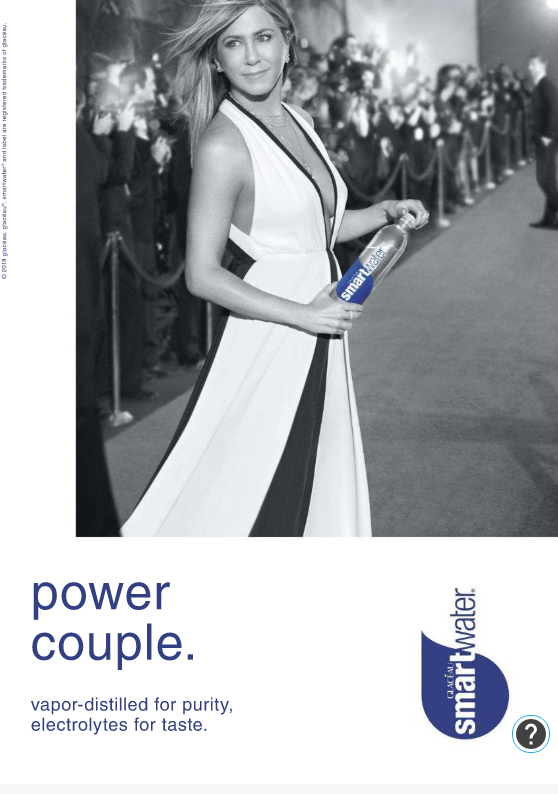Marketing Case File (Marketing)
Luxury Water

Ad from VANITY FAIR (April 2018)
The CASE FILE series — to which SEMIOVOX has invited our semiotician colleagues from around the world to contribute — shares memorable case studies via story telling.
In the mid 2010s, water had a ‘moment’. Every other FMCG semiotics brief seemed to be about the future of water, refreshment, hydration, liquid. Skincare companies wanted to hydrate better than others. Soft drink companies wanted to seem more water-like. Water companies wanted to offer more: taste, health, experience.
The category boomed, and aisles filled up with every kind of water. Water squeezed from birch trees, water with added electrolytes, juicy water, protein water, black charcoal water, coconut water in absolutely everything.
On the one hand, it was fun delving into the luxury world of water. In our research, we found water distilled through gold. Water ‘enhanced’ by music. Water sommeliers.
On the other hand, however, it felt utterly surreal. Dystopian even.
Water is a basic. We need it to survive. It felt crazy that you could (and still can) spend hundreds on a special kind of H2O, while climate change created droughts in East Africa. As Flint cried out for clean water. As the UK’s waterways became more and more polluted.
This isn’t the kind of thing you’d put in a report full of positive water examples. And to their credit, a bunch of brands do now encourage recycling, reusable water bottles, sponsor free drinking fountains in cities, support charities. They weren’t unaware of the contradiction, it just wasn’t part of this particular brief.
The 2010s water craze died down a little, as trends do. Some brands survived and became category staples, like Smartwater (with added electrolytes). Nowadays water bottles and home recipes dominate conversations instead, like the Stanley Cup and WaterTok (experimental flavoured water recipes on TikTok). You can still buy ridiculously expensive water, though, and access to clean water is still getting worse, e.g., in places like Sudan. The surreal contradiction persists.
I know this dystopian view can be applied to almost any category — food, sanitation, housing, health. Water though, just feels like the most basic human right there is. It’s peculiar, that it can be altered and packaged so much to become a luxury. That water, one of the most abundant, basic substances on the planet, can also be symbolised as rare, refined and exclusive. It’s fascinating.
I remain compelled by the category, forever zoning in on water options in shops and restaurants. With the rise of non-alcoholic alternative drinks, water maybe has the potential for another ‘moment’ in leisure and entertainment. Brands like Liquid Death are leading the charge — providing simple water in a goth metal can. It’s all branding, but it’s effective. We’ll have to watch this space.
CASE FILE: Sónia Marques (Portugal) on BIRTHDAY CAKE | Malcolm Evans (Wales) on PET FOOD | Charles Leech (Canada) on HAGIOGRAPHY | Becks Collins (England) on LUXURY WATER | Alfredo Troncoso (Mexico) on LESS IS MORE | Stefania Gogna (Italy) on POST-ANGEL | Mariane Cara (Brazil) on MOTHER-PACKS | Whitney Dunlap-Fowler (USA) on WHERE THE BOYS ARE | Antje Weißenborn (Germany) on KITSCH | Chirag Mediratta (India) on “I WATCH, THEREFORE I AM” | Eugene Gorny (Thailand) on UNDEAD LUXURY | Adelina Vaca (Mexico) on CUBAN WAYS OF SEEING | Lucia Laurent-Neva (England) on DOLPHIN SQUARE | William Liu (China) on SCENT FANTASY | Clio Meurer (Brazil) on CHOCOLATE IDEOLOGY | Samuel Grange (France) on SWAZILAND CONDOMS | Serdar Paktin (Turkey/England) on KÜTUR KÜTUR | Ximena Tobi (Argentina) on SLUM PANDEMIC | Maciej Biedziński (Poland) on YOUTH LEISURE | Josh Glenn (USA) on THE AMERICAN SPIRIT | Martha Arango (Sweden) on M | Chris Arning (England) on X | Peter Glassen (Sweden) on WHEN SHABBY ISN’T CHIC | Joël Lim Du Bois (Malaysia) on RECONSTRUCTION SET | Ramona Lyons (USA) on THE FALL.
Also see these international semio series: COVID CODES | SEMIO OBJECTS | MAKING SENSE | COLOR CODEX | DECODER | CASE FILE

